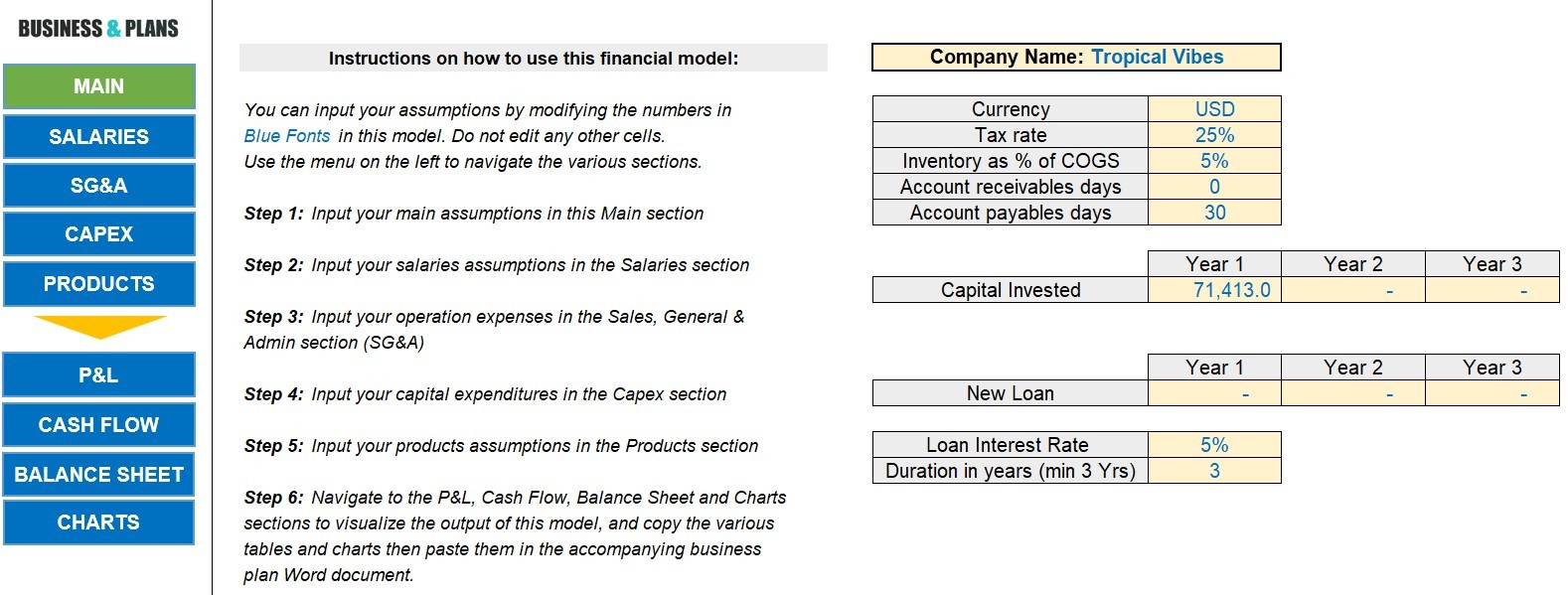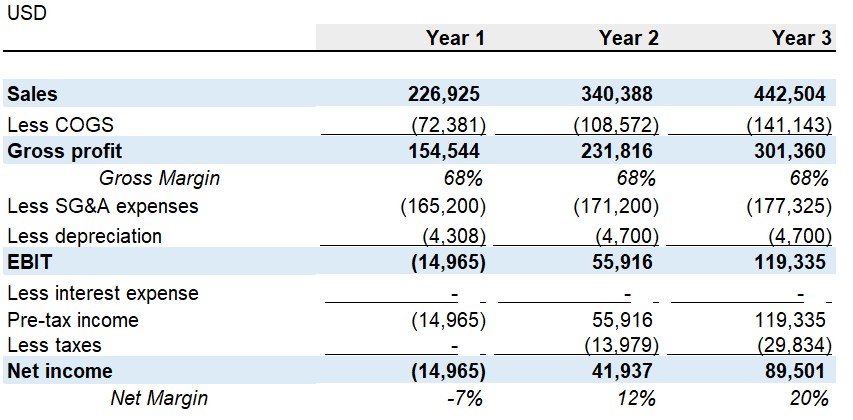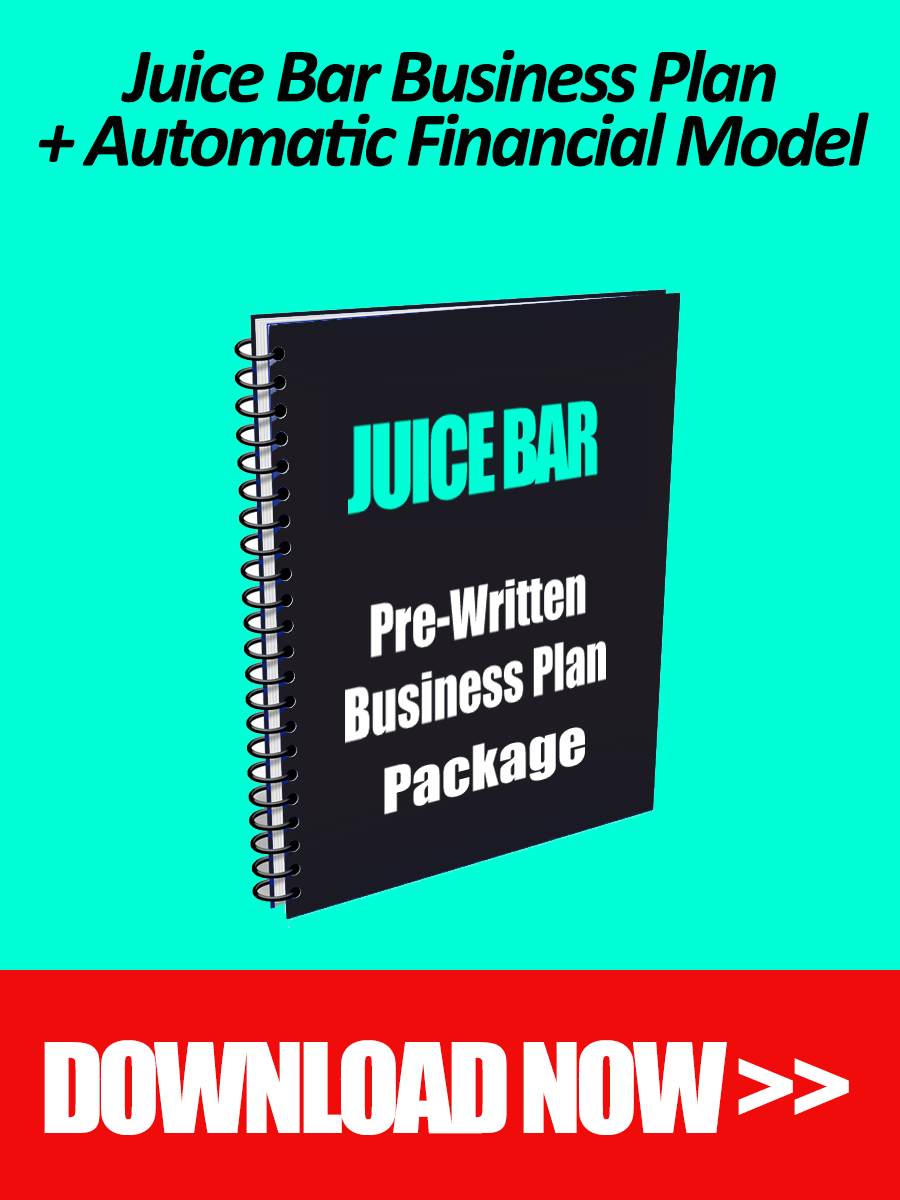Starting a Juice Bar can be an exciting and rewarding venture, but like any business, it requires careful planning to ensure success. One of the crucial components of this planning process is creating a comprehensive juice bar financial plan. A juice bar financial plan serves as a roadmap for your business, helping you understand the various financial aspects involved and make informed decisions to achieve your goals.
In this article, we will delve into the essential elements of a financial plan for a Juice Bar business. We will explore cost forecasting, capital expenditures, revenue forecasting, pricing strategies, break-even analysis, and the preparation of key financial statements such as the income statement, cash flow forecast, and balance sheet forecast. By understanding and developing these components, you’ll gain valuable insights into the financial viability and sustainability of your Juice Bar venture.
Juice Bar Financial Plan Template in Excel
A well-constructed financial plan not only provides a clear picture of the financial health of your business but also assists in securing funding, attracting investors, and guiding day-to-day financial management.
Before we begin, we wanted to briefly introduce our off the shelf automatic juice bar financial plan spreadsheet in Excel. It comes as part of our premium Juice Bar business plan bundle. Save a lot of time and money by downloading your ready-made Juice Bar financial plan now.
Now, let’s dive in and learn how to create an effective financial plan for your Juice Bar business, paving the way for a prosperous future!
Juice Bar Financial Plan: Cost Forecast
A cost forecast is a fundamental aspect of creating a financial plan for your Juice Bar business. It involves estimating and projecting the various expenses associated with running your day to day business. By accurately forecasting costs, you can make informed decisions about pricing, budgeting, and resource allocation. Here are some key considerations for developing a robust cost forecast:
Start-up Costs
When launching your Juice Bar, you’ll incur initial start-up costs. These may include expenses such as lease or purchase of a location, equipment, furniture, signage, licenses, permits, initial inventory, and website development expenses. Conduct thorough research and create a comprehensive list of all one-time expenses required to establish your Juice Bar.
Fixed Costs
Fixed costs are recurring expenses that remain relatively stable regardless of your sales volume. They typically include rent or mortgage payments, insurance, utilities, salaries of permanent staff, and monthly subscriptions or software fees. Identify all fixed costs associated with your Juice Bar and determine their monthly or annual amounts.
Variable Costs
Variable costs are expenses that fluctuate based on your revenues or production output. In the context of a Juice Bar, these costs primarily include the cost of ingredients and raw materials needed to prepare juices, smoothies, shakes and other offerings. Analyze supplier prices, estimate the quantity of ingredients required per product, and calculate the corresponding variable costs.
Overhead Costs
Overhead costs encompass indirect expenses necessary for the operation of your Juice Bar but not directly tied to a specific product or service. These may include general and administrative costs, marketing and advertising expenses, repairs and maintenance, professional fees (accountants, lawyers), and other miscellaneous costs. Estimate these expenses based on industry benchmarks and your specific business requirements.
Labor Costs
Labor costs involve the wages or salaries of your employees. Consider the number of staff members required to operate your Juice Bar efficiently, their roles and responsibilities, and the prevailing wage rates. Account for payroll taxes, benefits, and any additional employee-related expenses.
Contingency Fund
It’s prudent to allocate a portion of your budget as a contingency fund to cover unforeseen expenses or emergencies. A general rule of thumb is to set aside a percentage of your total costs, typically around 10% to 15%. This ensures you have a safety net to address unexpected financial challenges that may arise during the course of your business operations.
By carefully analyzing and estimating these costs, you’ll be better equipped to determine your pricing strategy, assess profitability, and develop a realistic financial plan. The accuracy of your cost forecast will directly impact the success and sustainability of your Juice Bar business. In the next section, we’ll explore capital expenditures and their significance in your financial plan.
Juice Bar Capital Expenditures
Capital expenditures (CAPEX) are investments made in long-term assets or improvements that benefit your Juice Bar business over an extended period. These expenditures typically involve acquiring or upgrading essential equipment, renovating the premises, or making significant infrastructure enhancements. Here’s a breakdown of capital expenditures and their importance in your financial plan:
- Equipment and Machinery: As a Juice Bar business, you’ll need specific equipment and machinery to prepare and serve your products efficiently. This may include juicers, blenders, refrigeration units, POS systems, furniture, and fixtures. Research the market, compare prices, and estimate the costs of purchasing these items.
- Facility Enhancements: Improving and renovating your Juice Bar’s physical space might involve upgrading the interior decor, lighting, seating areas, signage, or creating an appealing outdoor space. Evaluate the necessary renovations or improvements and estimate the associated costs.
- Technology Investments: In today’s digital age, investing in technology can streamline operations, improve efficiency, and enhance customer service. Consider investments in point-of-sale systems, inventory management software, online ordering platforms, customer relationship management (CRM) software, and website development.
Including capital expenditures in your financial plan demonstrates a long-term perspective and ensures you have the necessary resources to establish a strong foundation for your Juice Bar business. It is essential to estimate these expenditures accurately and consider their impact on your cash flow, profitability, and return on investment. In the next section, we will explore revenue forecasting and its significance in developing a comprehensive financial plan.
Juice Bar Financial Plan: Revenue Forecast
A revenue forecast is a crucial component of your juice bar financial plan as it projects the expected income your Juice Bar business will generate over a specific period. Here are some key considerations for developing an accurate revenue forecast:
Product and Service Offering
Begin by identifying the range of products and services your Juice Bar will offer. This may include fresh juices, smoothies, acai bowls, milkshakes, snacks, and other complementary items. Determine the pricing strategy for each offering, taking into account ingredient costs, market demand, and competition.
Sales Volume Projections
Research and analyze the potential market size for your Juice Bar business. Consider factors such as the local population, target demographics, and consumer preferences. Estimate the average number of customers you expect to serve per day or month, and calculate the projected sales volume based on this information.
Pricing Strategy
Determine the appropriate pricing strategy for your Juice Bar’s products and services. Consider factors such as ingredient costs, competitor pricing, perceived value, and target market preferences. Striking a balance between profitability and competitiveness is crucial.
Seasonal and Monthly Variations
Anticipate any seasonal or monthly variations in demand for your Juice Bar’s offerings. For example, during summer months, there might be increased demand for refreshing beverages, while winter months may see a shift towards warm and comforting options. Incorporate these fluctuations into your sales forecast to get a more accurate picture.
Marketing and Promotion
Consider the impact of your marketing and promotional efforts on sales. Develop a marketing plan that outlines strategies to attract and retain customers, such as social media campaigns, local partnerships, loyalty programs, and targeted advertising. Estimate the expected revenue uplift resulting from these initiatives.
Market and Industry Trends
Stay informed about market and industry trends that may influence your Juice Bar’s revenue potential. This includes factors like the growing demand for healthy food and beverages, rising interest in plant-based options, and evolving consumer preferences. Incorporate these trends into your forecast to align your business with market demand.
Remember, revenue forecasting involves making educated estimates based on available information and market research. While it may not be 100% accurate, it provides a framework for setting realistic goals and measuring the performance of your Juice Bar business. Next, we will explore pricing strategies and their importance in maximizing profitability.
Juice Bar Break-Even Analysis
A break-even analysis is a valuable tool for assessing the financial viability of your Juice Bar business. It helps determine the point at which your total revenue equals your total costs, resulting in neither profit nor loss. Conducting a break-even analysis allows you to understand the minimum level of sales needed to cover all expenses. Here’s how to perform a break-even analysis for your Juice Bar venture:
- Identify Fixed and Variable Costs: Start by categorizing your costs into fixed and variable categories. As explained previously, fixed costs, such as rent, insurance, and salaries, remain constant regardless of sales volume. Variable costs, on the other hand, fluctuate with the level of production or sales, such as ingredient costs or packaging expenses.
- Calculate Contribution Margin: The contribution margin is the amount left after deducting variable costs from your revenue. It represents the portion of each sale that contributes to covering your fixed costs and generating profit. Calculate the contribution margin of your juice bar by subtracting variable costs from your selling price or revenue per unit.
- Determine Fixed Costs: Identify and total all fixed costs associated with running your Juice Bar. This includes monthly rent, utilities, insurance, salaries, and any other fixed expenses.
- Calculate your Break-Even Point: To calculate the break-even point, divide your total fixed costs by the contribution margin. The resulting figure represents the number of units or sales dollars needed to cover all costs and break even. This analysis helps you understand the minimum sales volume required to avoid losses.
- Assess the Profitability of your Juice Bar: Once you have determined the break-even point, you can evaluate the profitability of your Juice Bar business. Compare your projected sales volume to the break-even point to determine the level of profitability above the break-even level. This information can guide pricing decisions and strategic planning.
- Sensitivity Analysis: You can perform a sensitivity analysis by adjusting key variables such as selling price, variable costs, or fixed costs to understand their impact on the break-even point and overall profitability. This analysis helps you assess different scenarios and make informed decisions to improve your financial performance.
By regularly reviewing and updating your break-even analysis, you can track your progress and take necessary actions to maximize profitability.
Juice Bar Income Statement
An income statement, also known as a profit and loss statement (P&L), is a financial statement that summarizes the revenue, expenses, and profitability of your Juice Bar business over a specific period. The P&L provides a comprehensive overview of your financial performance and helps you assess the profitability of your operations. Here’s how to prepare an income statement:
Revenue
Start by listing your total revenue from the sale of products and services. This includes sales of juices, smoothies, snacks…etc. Break down the revenue by category if applicable, such as different product lines or revenue streams.
Cost of Goods Sold (COGS)
Calculate the cost of goods sold, which includes the direct costs associated with producing or purchasing the products you sell. For a Juice Bar, this primarily includes the cost of ingredients, fruits, and packaging materials. Deduct the COGS from the revenue to determine the gross profit.
Gross Profit
Gross profit represents the difference between your revenue and the cost of goods sold. It indicates the profitability of your core business operations before considering other expenses. The Gross Profit margin is the gross profit divided by the revenue expressed in percentage.
Operating Expenses
List all your operating expenses, including rent, utilities, salaries, marketing expenses, insurance, and any other costs incurred in running your Juice Bar. If you wish, categorize these expenses into fixed and variable categories for better analysis.
Operating Income
Deduct the total operating expenses from the gross profit to calculate the operating income. This figure reflects the profitability of your business operations after considering all operating expenses.
Other Income and Expenses
Account for any additional income or expenses not directly related to your core operations. This may include interest income, investment gains or losses, or any extraordinary items. Include these items in the income statement to present a complete picture of your financial performance.
Net Income
Subtract the other income and expenses from the operating income as well as any taxes to calculate the net income. Net income represents the overall profitability of your Juice Bar business after considering all revenue and expenses. You can also calculate your Net Margin by dividing net income by revenues.
The income statement is an extremely important financial statement that helps you assess your periodical business performance. Investors pay particular attention to your P&L to make an informed decision about your venture.
Juice Bar Cash Flow Forecast
The cash flow forecast is a financial tool that projects the inflow and outflow of cash for your Juice Bar business over a specific period of time. It helps you anticipate and manage your cash needs, ensuring that you have sufficient funds to cover expenses and maintain a healthy cash position. Here’s an overview of key elements composing a typical cash flow statement:
Cash Inflows
Identify and estimate the various sources of cash inflows for your Juice Bar. This includes revenue from sales, any additional income from catering services, online orders, or partnerships. Consider the timing of these inflows based on your sales cycle and customer payment terms.
Cash Outflows
Categorize and forecast the cash outflows of your Juice Bar. This includes expenses such as ingredient purchases, rent or lease payments, utility bills, employee wages, marketing expenses, loan repayments, and other operational costs. Here again, the timing of these expenses and their due dates is a key factor not to neglect.
Opening Cash Balance
Begin your cash flow forecast with the opening cash balance, which is the amount of cash you have at the beginning of the forecasting period. This can be obtained from your previous financial records.
Cash Inflow Projection
Project your cash inflows based on your revenue forecast and expected payment terms. Consider any seasonality or fluctuations in cash receipts. Be realistic and conservative in your estimations to avoid overestimating your cash inflows.
Cash Outflow Projection
Estimate your cash outflows based on your cost forecast and payment terms with suppliers, employees, and other parties. Take into consideration any irregular or one-time expenses that may occur during the forecast period. Don’t forget to account for any planned capital expenditures as well.
Net Cash Flow
Calculate the net cash flow by subtracting the total cash outflows from the total cash inflows. A positive net cash flow indicates a surplus, while a negative net cash flow indicates a cash deficit. Aim to always monitor and analyze the net cash flow to ensure you have adequate cash reserves to cover expenses.
Closing Cash Balance
Finally, determine the closing cash balance by adding the net cash flow to the opening cash balance. This represents the amount of cash you will have at the end of the forecasting period. The closing cash balance provides insight into your Juice Bar’s cash position and liquidity.
Make sure to always monitor your cash flow situation for effective cash management. This will help you identify potential cash shortfalls in advance, make informed decisions regarding investments or expenses, and take proactive measures to maintain a healthy cash flow.
Juice Bar Balance Sheet Forecast
Let’s now review the final important statement, the balance sheet. The balance sheet is a financial statement that provides a snapshot of your Juice Bar business’s financial position at a specific point in time. It presents a summary of your assets, liabilities, and equity, allowing you to assess your business’s overall financial health. The following are the main elements of the balance sheet:
Assets
This includes current assets such as cash, inventory, accounts receivable, and prepaid expenses. It also includes long-term assets such as property, equipment, and any investments you may have made.
Liabilities
Liabilities comprise current liabilities such as accounts payable, accrued expenses, and any short-term loans or credit lines as well as long-term liabilities such as mortgages or business loans.
Equity
Equity includes the initial capital invested by the owners, any additional contributions, and retained earnings. Estimate the equity based on your capital structure and projected earnings.
Balance Sheet Projection
Prepare a balance sheet projection by organizing the estimated values of assets, liabilities, and equity. List the assets on the left side (or top) of the balance sheet and the liabilities and equity on the right side (or bottom). Ensure that the equation Assets = Liabilities + Equity holds true.
A proper balance sheet forecast provides a comprehensive view of your Juice Bar business’s financial position, showing the relationship between your assets, liabilities, and equity.
Conclusion
In conclusion, developing a comprehensive financial plan for your Juice Bar business is essential for setting goals, making informed decisions, and ensuring the financial success of your venture.
By conducting thorough research, accurate estimations, and regular reviews, you can create a solid foundation for your Juice Bar business’s financial success. Remember to revisit and update your financial plan as market conditions, costs, and business circumstances evolve.
If you wish to save time and money then we highly recommend to download our ready-made juice bar financial plan in Excel. This is part of our premium Juice Bar business plan package prepared by financial planning experts.
Remember, a well-developed financial plan will not only assist you in securing financing but also provide you with a roadmap to monitor and manage your Juice Bar’s financial performance effectively.
Good luck with your Juice Bar venture!








